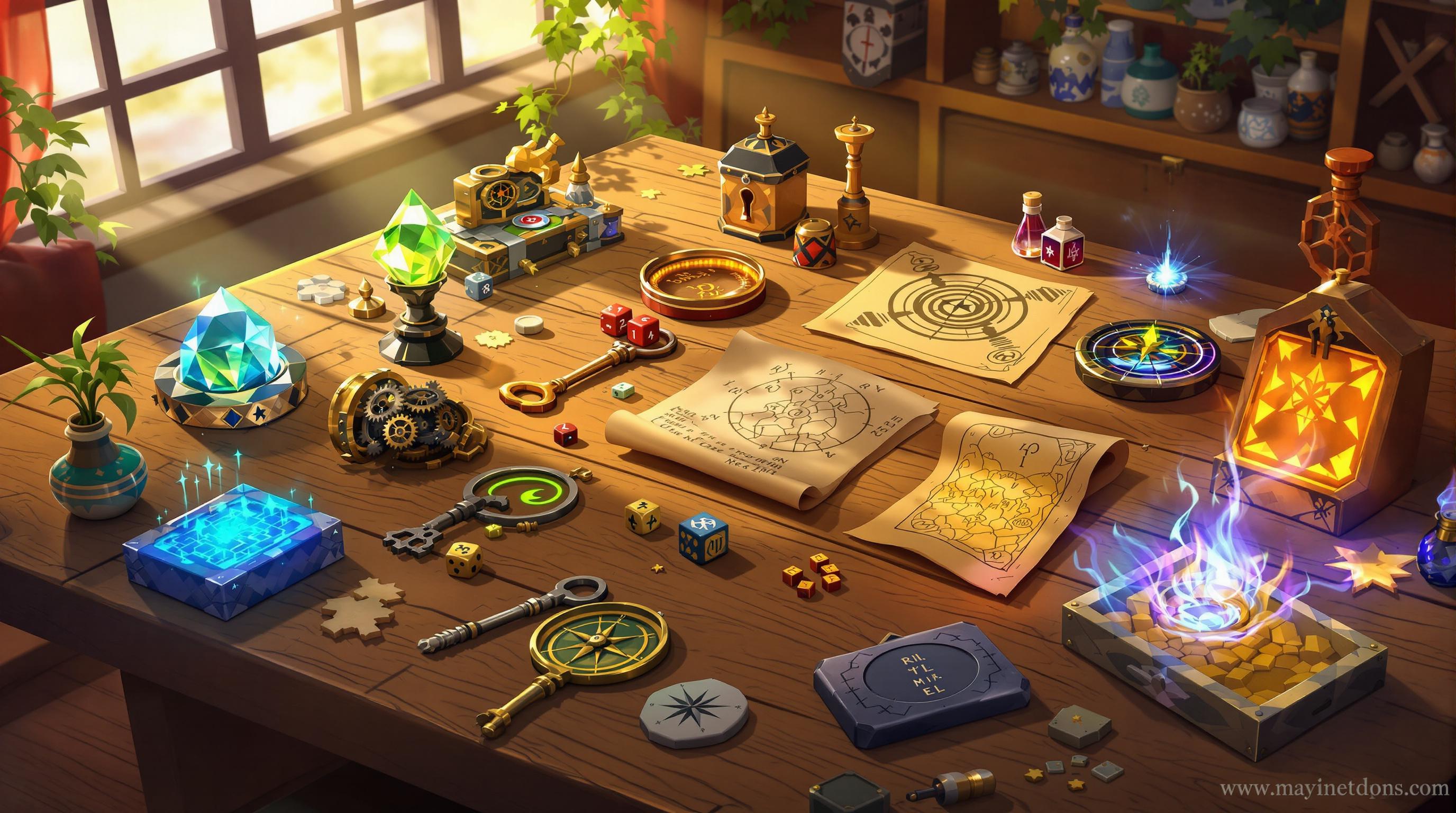Environmental storytelling in RPGs is all about creating immersive worlds where players discover stories through exploration. Instead of relying on dialogue, this technique uses visual details, dynamic environments, and atmospheric design to convey narratives. Games like BioShock and The Witcher 3 showcase how architecture, props, and evolving landscapes can reflect themes, emotions, and player choices.
Key Takeaways:
- Visual Details: Use objects, architecture, and wear-and-tear to tell stories (e.g., Rapture in BioShock).
- Dynamic Environments: Make the world respond to player actions with weather, destructible elements, or seasonal changes.
- Atmosphere: Combine lighting, sound, and environmental effects to evoke emotions (Dead Space excels here).
- Cultural and Natural Elements: Reflect civilizations and ecological themes to enrich world-building (The Witcher 3, The Last of Us).
This approach turns players into active participants, piecing together the story naturally. Whether you're designing video games or tabletop RPGs, these methods enhance immersion and create memorable experiences.
Techniques for Effective Environmental Storytelling
Using Visual Details for Storytelling
Visual details play a critical role in shaping narratives within RPG environments. Elements like props, architecture, and environmental design work together to convey stories without relying on dialogue. Take BioShock, for instance: the crumbling art deco architecture and waterlogged halls of Rapture vividly illustrate the downfall of Andrew Ryan's utopian dream [1]. Every shattered window, tattered banner, and discarded luxury item paints a picture of societal collapse.
Environmental puzzles can also add layers to storytelling. In Metroid Prime, the Scan Visor mechanic invites players to piece together the history of the Chozo civilization through artifacts and architectural clues [3]. This approach not only rewards curiosity but also pulls players deeper into the world by encouraging exploration.
Dynamic Environments Responding to Player Actions
When environments react to player decisions, they create a sense of impact and immersion. The Last of Us excels in this area, showcasing shifting post-apocalyptic landscapes that evolve with the story and seasonal changes [1].
Some key ways dynamic environments enhance storytelling include:
- Weather Systems: Storms or darkening skies heighten tension before pivotal moments.
- Destructible Elements: Damaged walls or scorched surroundings reflect past battles.
- Adaptive Landscapes: Villages rebuilding after quests give players a sense of progress.
These dynamic touches make the world feel alive and responsive, reinforcing the weight of player choices.
Non-Verbal Storytelling with Atmosphere
Atmosphere, created through cues like sound, lighting, and environmental effects, can tell stories in subtle yet powerful ways. Dead Space demonstrates this brilliantly, using darkness, eerie sounds, and deteriorating surroundings to evoke fear and convey a narrative of survival [3].
Here’s how these elements work together:
| Element | Purpose | Example |
|---|---|---|
| Lighting | Sets tone and guides players | Dynamic shadows in abandoned areas |
| Sound Design | Evokes emotion | Distant echoes, creaking structures |
| Environmental Effects | Deepens immersion | Weather effects, particles in motion |
When used thoughtfully, these details allow players to uncover stories naturally. The result is a world that feels lived-in, where every element contributes to the narrative without overwhelming the player with obvious cues.
Influences on RPG Environments
Drawing from Cultural Inspirations in Landscapes
Incorporating cultural elements like architecture and traditions can make RPG worlds feel more grounded and engaging. Take BioShock, for example - its Art Deco design and 1950s American influences vividly represent Rapture's societal ideals and eventual downfall [1]. Similarly, The Legend of Zelda: Breath of the Wild integrates inspirations from various civilizations into its world design, making each region feel distinct and immersive [2].
| Element | Purpose | Impact |
|---|---|---|
| Architecture | Reflects values | Shapes city layouts |
| Customs | Establishes norms | Influences NPCs and settlements |
| Historical ruins | Adds context | Creates artifacts and remnants |
While cultural details define the identity of a civilization, the natural environment plays an equally important role by adding depth and connecting the world to its broader narrative and emotional tone.
Ecosystems as Tools for Storytelling
Natural environments can tell stories and evoke emotions without relying on words. In The Last of Us, for instance, overgrown cities represent nature reclaiming what was once man-made, reinforcing themes of survival and loss [1]. This kind of storytelling uses visual and ecological cues instead of direct exposition.
Weather, seasons, and natural features also enhance storytelling by setting the tone, marking the passage of time, or reflecting societal conditions. For example, Half-Life 2 uses dynamic environments to create tension and atmosphere, making the world feel alive and responsive to unfolding events [1]. These ecological details can serve several purposes:
- Setting the mood with weather and lighting
- Marking time through seasonal shifts
- Reflecting societal health through environmental changes
To implement these elements effectively, developers should aim for thematic consistency while balancing detail and subtlety. For tabletop RPG creators, resources like the TTRPG Games Directory can provide inspiration for blending cultural and ecological storytelling across various genres. When combined thoughtfully, cultural and environmental storytelling techniques create immersive worlds that leave a lasting impression on players.
Examples of Environmental Storytelling in RPGs
BioShock: Storytelling Through Setting
In BioShock, the underwater city of Rapture tells its story through its surroundings. The Art Deco architecture, now in ruins, mirrors the society's collapse. Cracked walls, water-damaged murals, and abandoned luxury items silently convey the aftermath of a failed utopia. Meanwhile, audio logs scattered throughout the game provide additional context, encouraging players to explore and uncover the city's history.
Here's how BioShock uses its environment to tell a story:
| Storytelling Element | Narrative Purpose | Player Impact |
|---|---|---|
| Audio Logs | Share backstory through discovered recordings | Allows players to piece together events naturally |
| Architectural Decay | Reflects societal and physical collapse | Enhances atmosphere and immersion |
| Environmental Props | Personal objects and written messages | Creates emotional ties to past events |
For tabletop RPGs, similar approaches can be used by designing environments that reflect the themes and history of the world.
The Witcher 3: World-Building with Details
The Witcher 3 excels at creating immersive environments packed with narrative depth. Every location, from war-ravaged battlefields to tranquil villages, tells a story. These visual narratives reward players who take the time to explore.
The game employs several techniques for environmental storytelling:
- Cultural Details: Villages and towns showcase unique cultural traits through architecture and everyday life.
- Dynamic Weather: Changing weather patterns add to the mood and influence gameplay.
- Environmental Scars: Abandoned homes, monster nests, and battlegrounds reveal tales of conflict, survival, and loss.
For instance, a burnt-out village doesn't just show destruction. It hints at monster attacks, the impact of war, or political struggles - all through carefully placed details. In RPGs, using these methods can encourage players to dig deeper into the world, discovering hidden layers and untold stories through subtle environmental cues.
These examples highlight how environmental storytelling can build rich, immersive worlds. Tabletop RPG creators can borrow these techniques to craft engaging narratives that resonate with players.
sbb-itb-b8b00a5
Tips for Using Environmental Storytelling in RPGs
Start with Thoughtful World-Building
Environmental storytelling thrives on a well-developed world. Weave in history, cultural nuances, and physical changes to craft spaces that tell their own stories. Here are some key elements to consider:
| Element | Examples to Include |
|---|---|
| Historical Timeline | Ancient ruins, evolving architecture |
| Environmental Changes | Weathering, seasonal transformations |
| Character Presence | Personal belongings, recent activities |
Each detail should contribute to the bigger picture, aligning with the story's central themes. A carefully built world creates a strong foundation for storytelling through the environment.
Keep Themes Consistent
Your environment should reflect the game's themes and tone at all times. This consistency enhances immersion and allows players to uncover the story naturally as they explore.
Tips for maintaining consistency:
- Use recurring visual motifs across connected areas.
- Match architectural styles to the local culture or setting.
- Adjust weather and lighting to reflect the intended mood.
- Show story progress through visible environmental changes.
Take inspiration from other games that excel in using their environments to reinforce themes and tone.
Explore the TTRPG Games Directory for Ideas
The TTRPG Games Directory is a great tool for sharpening your environmental storytelling skills. Dive into its collection to see how various games successfully merge setting and narrative. Focus on:
- Titles in your genre that stand out for their environmental design.
- Systems that effectively combine mechanics with world-building.
- Creative methods of non-verbal storytelling that enhance immersion.
How Level Design Can Tell a Story
Conclusion: Key Points on RPG Environmental Storytelling
Environmental storytelling brings game worlds to life, turning them into rich, interactive spaces where players uncover narratives through exploration and observation. By weaving story elements into the environment, developers can create deeper connections and more engaging experiences for players.
Games like BioShock and The Witcher 3 highlight how this method can communicate themes and immerse players through carefully crafted world design [1]. This technique has reshaped how developers approach creating meaningful player interactions.
| Storytelling Element | How It's Used | Effect on Players |
|---|---|---|
| Visual Details | Architecture, wear and tear, debris placement | Instantly sets a narrative tone |
| Dynamic Environments | Weather, time of day, changing seasons | Enhances the sense of a living world |
| Cultural Elements | Symbols, traditions, and local customs | Adds layers to world-building |
The TTRPG Games Directory showcases examples across different genres, offering inspiration and guidance for developers aiming to integrate environmental storytelling into their projects.
Key points to remember:
- Build environments that show rather than tell the story.
- Ensure environmental elements align with the game's core themes.
- Use ecosystems and cultural details to make the world feel lived-in.
- Reflect player choices and historical events through changes in the environment.
FAQs
Here are answers to common questions about using environmental storytelling in RPGs:
What is environmental storytelling?
Environmental storytelling involves using objects, architecture, and visuals to tell stories within a game world. Players uncover these narratives by exploring and interpreting their surroundings, offering a more immersive experience than traditional dialogue or exposition.
| Element | Purpose | Example |
|---|---|---|
| Visual Details | Share history and context | Graffiti hinting at civil unrest |
| Dynamic Elements | Make the world feel alive | Weather or terrain changes tied to story events |
| Cultural Markers | Add depth to world-building | Architecture or symbols tied to the game’s lore |
How do dynamic environments improve storytelling?
Dynamic environments respond to player actions and story developments, making the world feel interactive and alive. Features like destructible objects or evolving landscapes reflect choices players make, enhancing immersion through visible consequences.
Why is environmental storytelling effective in RPGs?
This approach draws players in by letting them discover the story organically, rather than relying on direct exposition. By blending subtle hints with clear narrative cues, players are encouraged to explore and piece together the story themselves, making the experience more rewarding.
How can developers ensure consistency in environmental storytelling?
Consistency requires careful attention to detail. Key areas include:
- Visual design: Use recurring motifs and uniform architectural styles.
- Atmosphere: Combine lighting and sound to create a cohesive mood.
- Cultural details: Align world-building elements with the game’s tone and backstory.
For inspiration, the TTRPG Games Directory highlights various ways developers have used environmental storytelling to create engaging, story-rich RPG worlds.


